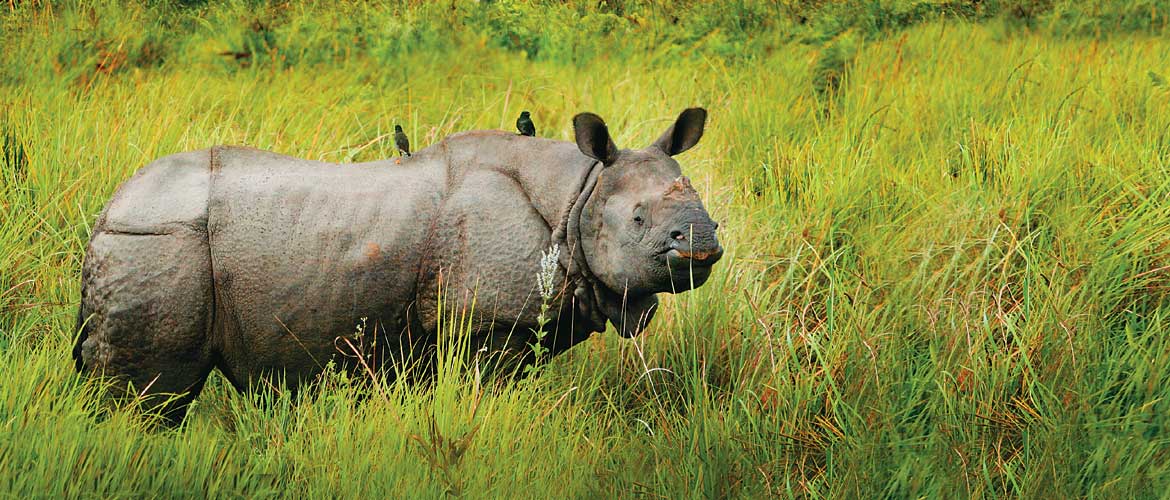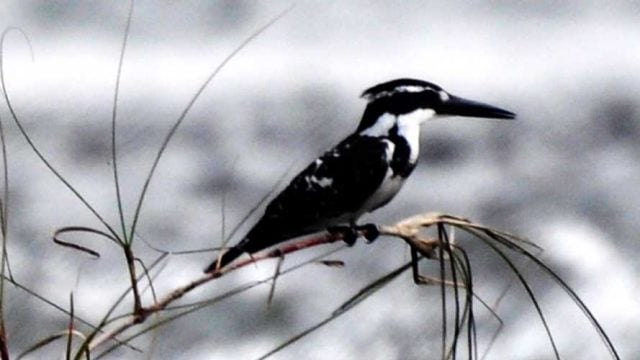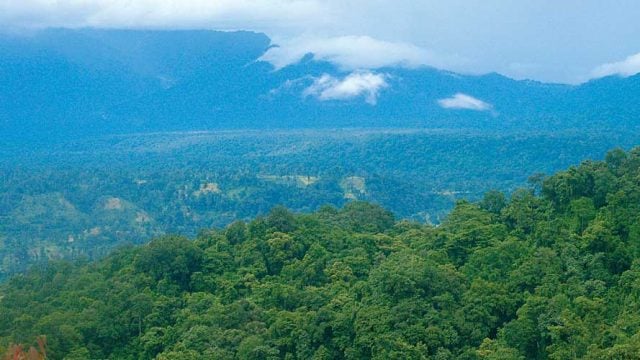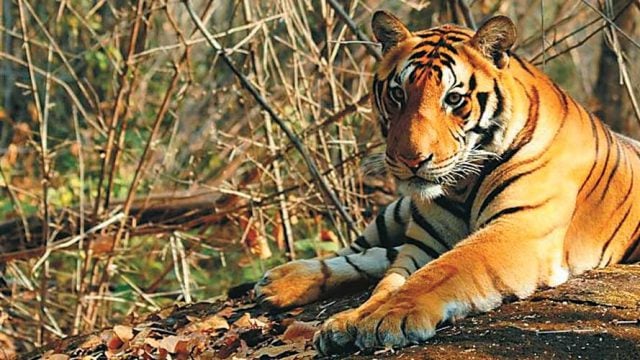It was pouring when we rolled into the Jaldapara Wildlife Sanctuary. As we passed the huge green
Jaldapara is home to an estimated 108 rhinos. But this wildlife sanctuary has much more to offer. The most awe-inspiring element here is the forest itself. Looking at the dense foliage and tall trees that seem to close in upon us, I felt shivers go down my spine – of excitement mixed with some amount of trepidation. My journey began in New Jalpaiguri, where I met my guide and driver Jayanto.
Our first stop was the Gorumara National Park, 75km from Siliguri. I had chosen the wrong time of the year to visit, I should add. It was raining and the parks had been closed for the monsoons. It was after much wrangling and requesting that we finally got the necessary permits to visit the forest.
The first day, I stayed at the Gorumara Jungle Camp run by Help Tourism, my tour operator. The visit to the park had to wait till the next morning. After a well-deserved nap, Jayanto and I set off for the Jaldhaka bridge nearby, which was not particularly remarkable. The light was fading fast, so we decided to return to the camp. We were driving along the highway and all I could see was dark green foliage on both sides. Suddenly the car swerved violently. “Pothole?” I asked. “Pothole! Didn’t you see the elephants crossing?” exclaimed Jayanto excitedly. I had just missed everything! So we turned around, switched off the lights and waited silently. Sure enough, after a few moments, a herd of seven adult elephants and two calves rumbled across the road and disappeared into the darkness.
Early morning the next day, we entered the park. The rain was incessant, but we were on a tight schedule. The skies cleared up a bit later and I could then look around. I had never seen such dense greenery anywhere else.

There were ferns everywhere and the tall trees were covered with creepers and moss. The place was dank with the smell of rotting vegetation. Every now and then, we could hear the sounds of various insects and birds. There are rhinos in Gorumara too, as well as elephants, bison and deer. But lady luck refused to smile on us and after an unsuccessful visit to Rhino Point, a watchtower, we left the forest.
It was raining again as we set out from Gorumara to Jaldapara and, after an hour and a half, we reached Madarihat, the entry point into Jaldapara. This was where our tourist lodge was located. The halt at the forest department office was thankfully brief this time. Word had got around, it seemed, and we obtained our permits in no time. Near the office, I saw an enclosure with small cages, used for the purposes of rehabilitating leopards. I saw a restless, pacing leopard and wondered when its time would come to return to the forest.
The next day, with Ajoy, our guide, we entered Jaldapara. After a while, the dirt road led us to the Hollong Tourist Lodge. This is an ideal place to stay, within the forest premises. But as it was off-season, it was closed. With star-struck eyes, Ajoy told us that parts of the film Mr & Mrs Iyer were shot here. I saw a few forest department elephants lazing around – clearly, it was off-season for them too. Unfortunately for me, it meant I could not enjoy an elephant ride, the best way to explore Jaldapara.
Jaldapara teems with plant and animal life. Everywhere I looked, there were trees, the most prominent being the tall sal and shishu trees. Being an ignorant city dweller, I failed to recognise the other flora. The canopy was so dense that hardly any sunlight fell on the forest floor. Here and there, amidst the under-growth of ferns, shrubs and tall grass, I spotted pretty peacocks. They showed off in front of us and disappeared into the bushes when we approached closer. But I still hadn’t seen my rhino, and I fretted in my seat. Jayanto, the seasoned veteran, had seen it all. Patience and luck are the name of the game, he told me. Silence reigned all around, to be broken at intervals by the calls of various birds. This birdwatchers’ paradise has an estimated 350 bird species, of which the rarest is surely the Bengal florican, sighted only a few times. It’s also home to numerous mammal, reptile and insect species, but the main attraction is definitely the Indian rhino.

After driving around for 15 minutes, we reached one of the watchtowers. From the top of the tower, I could see vast swathes of grassland and huge trees beyond it in the mist. The Torsa and Malangi rivers flow close by. Also near the watchtower are interlocking water channels with muddy banks covered by shrubs and marshy vegetation. I spotted the circular salt pits made by the forest department where animals usually congregate for much-needed nutrients. But there were no animals to be seen. Feeling a bit desperate but still expectant, I waited for what seemed like hours. And all the while, it was drizzling. Ultimately, it was a no show and I trudged back dejectedly to the Sumo. Our enthusiastic guide urged us to move to another tower. By now, I could almost see the writing on the wall. And sure enough, at the next watchtower, it was the same story. On the way back, as consolation, we spotted two beautiful hog deer, a mother and her calf. No one moved. The deer and the humans in the car eyed each other. As I reached for my binoculars the deer sprinted into the tall grasses. I didn’t get to see any rhinos this time – but I’ll be back, when it’s not raining.
About Jaldapara Wildlife Sanctuary
Established in 1941 primarily for the protection of rhinos, Jaldapara is home to the largest concentration of the one-horned rhino in India after Kaziranga National Park. A variety of other animals and birds make their home within its 100sq km area. The climate is moist tropical with heavy monsoons, encouraging luxuriant foliage growth. The sanctuary is uninhabited, but the surrounding areas are heavily populated – there’s a large tribal population. This has had the inevitable result of endangering the park, mostly as a result of illegal grazing by livestock, collection of forest produce and poaching.
Plans are afoot to merge the sanctuary with Buxa Tiger Reserve under the title of national park to ensure better conservation efforts and management.
Orientation
With two rivers, Torsa and Malangi, flowing through it, Jaldapara offers a mixed tapestry of extensive grasslands along the sandy banks of the rivers and thick forests of mainly deciduous trees. Several streams crisscross the park. The approach along NH31C from the Gorumara National Park area to Madarihat, the entrance to Jaldapara, is through vast tracts of tea fields.
The Nature Interpretation Centre, near the Assistant Wildlife Warden’s office at Madarihat provides information and also arranges permits and bookings for elephant and jeep safaris. A 10-minute drive from the gate brings you to the Jaldapara Tourist Lodge (sometimes referred to as the Madarihat Tourist Lodge). The lodge authorities also help arrange jeep and elephant safaris in collaboration with the forest office.
Close to the lodge is the Leopard Rehabilitation Centre. A short distance past the leopard enclosure is the Nature Interpretation Centre. The Hollong Lodge, about 7km away, is located in a forest clearing, with the Torsa and Malangi rivers not too far away. It also has a range officer who helps co-ordinate permits and elephant and jeep safaris. There are watchtowers and salt licks close to the water bodies, and these of course provide the best wildlife-viewing opportunities.
Things to See & Do
With its pleasant winters and mild summers, Jaldapara is a great holiday destination at any time of the year except the monsoons. Go rhino-spotting on elephant-back, admire bird species, marvel at the dense jungles, or simply savour the feeling of being in the wild. Safaris offers photographic opportunities as well.

Elephant Safaris
The best way to explore Jaldapara is by taking the one-hour elephant safari, which begins early in the morning. A maximum of four people are allowed on each elephant. The safari from the Tourist Lodge at Madarihat is subject to the availability of elephants from Hollong, whose guests have guaranteed safaris. Remember that elephant rides are in short supply in the high season. Be pre-pared to take a jeep safari instead.
◆ Safari fee ₹ 500 per head Timings 6.00–7.00am, 7.15–8.15am, 8.30–9.30am, 9.45–10.45am Elephant ride ₹ 660 per head (minimum 4 pax) Personal vehicle entry ₹ 275 Guide Rs. 100 Vehicle hire from Madarihat ₹ 400–500
Jeep Safaris
If you don’t trust elephants, this is your best bet. Of course, the excitement level is less and you can’t get very close to the animals. The park authorities don’t provide vehicles, so you’ll have to rent one from the Tourist Lodge at Madarihat or a tourist agency. A forest guard must accompany the jeep.
◆ Safari fee ₹ 1,640 (5–6 pax) Timings 6.00am, 8.00am, 1.00pm and 3.00pm Guide ₹ 200 per vehicle
Leopard Rehabilitation Centre
This centre gives you the opportunity to see how abandoned leopard cubs are reared to live in their natural habitat as adults.
Birdwatching
If you are an enthusiast, Jaldapara will be tremendously appealing, for it shelters a huge variety of birds such as hornbills and drongos.

The sanctuary is also the last known habitat of the Bengal florican.
So take a pair of binoculars, park yourself in one of the watchtowers and enjoy the sight. You can also walk around some areas – just make sure that you have a forest guide with you.
Where to Stay
There are not many accommodation options available here, so it pays to reserve your rooms well in advance. A sensible thing to do is to make your bookings through a tour operator. That way you can also bypass the hassle of getting the permits for entering the sanctuary. Help Tourism (helptourism.com) arranged my complete tour and I was quite satisfied. What’s more, Help Tourism is an association that works closely with the locals to ensure that everybody benefits. A minimum stay of 2–3 days is recommended. Bookings for both Hollong and Jaldapara tourist lodges can be made with West Bengal Tourism in Siliguri and Kolkata.
The best place to stay in Jaldapara is WBTDC’s Hollong Forest Lodge (Kolkata Tel: 033-22436440, 22488271; Tariff: ₹ 3,000). Its USP is that it’s situated in the heart of the sanctuary itself. Also you don’t have to wake up at an ungodly hour to make it for the early morning elephant safari. It has five double rooms. Elephant safaris are guaranteed for those staying here.
Jeep safaris can also be arranged through the wildlife office at Madarihat. Elephant safari spot bookings can be done at the District Forest Officer.
The other option is WBTDC’s Jaldapara Tourist Lodge (Tel: 03563-262230; Tariff: ₹ 1,600–3,200) at Madarihat. The lodge, about 2km from the sanctuary gates, has nice rooms. There are 22 double rooms, 11 cottages and a suite. It has a restaurant as well as a bar and internet facilities. The lodges can also be booked with the DFO, Nilkuthi, Cooch Behar (Tel: 03582-227513).
The Malangi Tourist Lodge (Tel: 03561-286398, Cell: 08172087842; Tariff: ₹ 2,274, dorm ₹ 1,522) at Barodabri, near Hasimara Chowpatty, is managed by West Bengal Forest Development Corporation. It has seven rooms and two dorms with eight beds each. Bookings have to be made online on wbfds.com or at their office in Kolkata (Tel: 033-23350064).
The West Bengal State Forest Development Agency (Tel: 033-23346900, 64994999, wbsfda.gov.in) offers eco-resorts in the region.
Mendabari Jungle Camp (Tariff: ₹ 1,200) offers two rooms; Kunjanagar Eco Park (Tariff: ₹ 3,000) has four rooms; and South Khairbari Eco Park (Tariff: ₹ 1,300) offers three rooms. All have a canteen and attached bath. Book online. You can also stay at Help Tourism’s (Kolkata Tel: 033-24550917, Cell: 09733000447, (helptourism.com) Jalda-para Jungle Camp (Tariff: Rs. ₹ 1,200–2,000). It offers 10 rooms, jungle safari and elephant rides. Other private properties include Acacia Eco Resort (Cell: 09831865310, 09477175411; Tariff: ₹ 1,500–2,500) near the entry gate; and Resort Heaven Inn (Tel: 03563-262357, Cell: 09733163466; Tariff: ₹ 1,200–3,000)
Where to Eat
The culinary experience at Jaldapara is limited. The tourist lodges offer standard fare, which is simple vegetarian and non-vegetarian Bengali and north Indian food. Meals are more or less mandatory in the lodges. Jaldapara Tourist Lodge has a bar.

Around Jaldapara Wildlife Sanctuary
Gorumara National Park (62km)
Closer to Siliguri (75km on NH31C), Gorumara makes a convenient stopover on the way to Jaldapara. Or you can halt here on the way back. Stay for at least a couple of days to enjoy the varied flora and fauna of this park situated on the bank of Murti river. Remember to carry a camera, as the park offers wonderful photo opportunities.
The one-horned rhino can be found here too. Declared a wildlife sanctuary in 1949 and upgraded to a national park in 1992, Gorumara is actually well worth a separate trip. It offers good birding opportunities.
You can stay at the riverside Bonani Tourist Centre (Kolkata Tel: 033-23350064; Tariff: ₹ 1,200–2,500; Bookings can be made online at (wbtdc.com), which is located on the highway near Chalsa. Sometimes referred to as the Murti Tourist Centre, it is run by WBFDC.
Totopara (30km)
A village on the banks of the Torsa river bordering Bhutan, Totopara is the only habitation of the Totos, an aboriginal tribe. Their numbers have dwindled over the years and there are fewer than a thousand of them left. Help Tourism can arrange an anthropological excursion.
Chilapata (25km)
Chilapata forest falls on the way to Cooch Behar from Jaldapara. This is another dense forest with elephants and leopards. But, be warned, by far the most dangerous inhabitants of the forest are armed robbers! In fact, less than three vehicles are not allowed into the forest at any given time for security reasons. The prime reason for hazarding such a trip would be to visit the fifth-century Nal or Mendabari Fort, located near the Bania river.
Built during the reign of the Nal dynasty, the fort is said to date back to the Gupta period and is mentioned in Marco Polo’s travelogue. Now only some remnants of the fort are to be found. There is a stone temple close by, but to get there, you have to walk along a path infested with snakes and other wild animals.
Where to stay
Chilapata Jungle Camp (Kolkata Tel: 033-24550917; Tariff: ₹ 1,200–1,500) is a good accommodation option. Contact Help Tourism to make a booking (Tel: 033-24550917).
Buxa Tiger Reserve (72km)
Set up in 1982–83, Buxa is one of India’s newest tiger reserves. The name is derived from the Buxa Fort – a fort on the Sinchula Range guarding the most important of the 11 routes into Bhutan. With an area of 760sq km, the reserve consists of mostly hilly terrain, which is criss-crossed by various rivers and streams. The generic diversity of mammals here is the second highest amongst all the tiger reserves in India. Apart from the Royal Bengal tiger, you can also find the elephant, leopard, Malayan giant squirrel, gaur, several types of deer and many others.
The Buxa Reserve can be reached via NH31 from Jaldapara. Gracilips Rest House (Tariff: ₹ 1,200–1,500), a private rest house at Rajabhatkhawa, has comfortable accommodation.
Fast Facts
When to go The park is open from 15 September–15 June. It is closed during the monsoons. Best time to visit is October–early May
Go there for One-horned rhino, bison, elephant, Bengal florican, barasingha, pygmy hog
Wildlife/ Forest Dept offices
Range Office
Ecotourism and Research Range
Madarihat, Cooch Behar
Cell: 09734190119
DFO, Cooch Behar
Tel: 03582-227185
Divisional Forest Officer (Wildlife III)
Nilkuthi, Cooch Behar
Tel: 227513 (For FRH booking)
West Bengal Forest Development Corporation (WBFDC) 6A, Raja Subodh Malik Square
7th Fl, Arya Mansion, Kolkata
Tel: 033-23350064
STD code 03563
State West Bengal
Location In Alipurduar sub-division of Jalpaiguri District in north Bengal, past vast tracts of tea plantations in the Dooars region, close to the Bhutan border
Distance 133km E of New Jalpaiguri
Route from Siliguri NH31 to Dalgaon via Coronation Bridge, Dam Dim, Mal Bazaar and Chalsa; NH31C to Madarihat via Birpara
Getting There
Air Nearest airport: Bagdogra (135km/ 3hrs). Take a taxi to Jaldapara via Siliguri and Madarihat. Vehicle options range from vans to 4-seater coaches (₹ 2,500) and Scorpios (₹ 3,500)
Rail Nearest railhead: New Jalpaiguri (148km/ 3hrs). Take a cab via Siliguri as above
Road There are two approach roads from Siliguri/ Bagdogra – NH31 and NH31C via Coronation Bridge and Gorumara National Park, and the state highway through Dhupguri, with both roads meeting at Telipara More (Ethelbari). You can avail of taxis or shared jeeps depending on your budget
Jaldapara Wildlife Sanctuary
Kingshuk Niyogy
OT Getaway Guides





